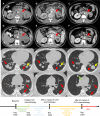Durable and deep response to CVD chemotherapy in SDHB-mutated metastatic paraganglioma: case report
- PMID: 39744181
- PMCID: PMC11688215
- DOI: 10.3389/fendo.2024.1483516
Durable and deep response to CVD chemotherapy in SDHB-mutated metastatic paraganglioma: case report
Abstract
Introduction: Succinate dehydrogenase subunit B (SDHB)-mutated paragangliomas (PGLs) are rare neuroendocrine tumors characterized by increased malignancy, readily metastasizing, and poorer prognosis. Here we report a case of SDHB-mutated metastatic PGL, wherein the patient showed significant tumor shrinkage and complete symptom remission following chemotherapy. We aim to contribute additional evidence to the existing knowledge associated with SDHB-mutated PGLs.
Case report: A 40-year-old male patient presented with recurrent hypoglycemia and hypertension crisis. Imaging revealed a huge left retroperitoneal tumor and multiple diffuse metastases in lungs. Catecholamine was also elevated, aligning with a diagnosis of metastatic PGL. Pathology also confirmed this diagnosis. Additionally, the immunohistochemistry indicated negative expression of SDHB and gene test showed somatic SDHB mutation. Given the SDHB mutation, cyclophosphamide-vincristine-dacarbazine (CVD) chemotherapy was initiated in critical conditions. Subsequently, a significant tumor shrinkage and complete biochemical response were observed after two treatment cycles. In September 2024, CT scan revealed new pulmonary lesions. The progression-free survival (PFS) with CVD chemotherapy was 24 months.
Conclusion: This report reviews the distinct clinical and biochemical characteristics and treatment approaches of SDHB-mutated paragangliomas, emphasizing that the significance of incorporating both genetic testing and immunohistochemical analysis in clinical practice.
Keywords: CVD chemotherapy; SDHB-mutation; case report; hypoglycemia; metastatic paraganglioma.
Copyright © 2024 Zhang, Wei, Cheng and Cao.
Conflict of interest statement
The authors declare that the research was conducted in the absence of any commercial or financial relationships that could be construed as a potential conflict of interest.
Figures



Similar articles
-
A novel germline (c.314T>A) SDHB variant in metastatic paraganglioma: case report and literature review.Front Endocrinol (Lausanne). 2025 Mar 27;16:1577421. doi: 10.3389/fendo.2025.1577421. eCollection 2025. Front Endocrinol (Lausanne). 2025. PMID: 40213107 Free PMC article. Review.
-
Successful chemotherapy of hepatic metastases in a case of succinate dehydrogenase subunit B-related paraganglioma.Endocrine. 2009 Oct;36(2):189-93. doi: 10.1007/s12020-009-9219-6. Epub 2009 Jul 18. Endocrine. 2009. PMID: 19618298 Free PMC article.
-
SDHB mutations are associated with response to temozolomide in patients with metastatic pheochromocytoma or paraganglioma.Int J Cancer. 2014 Dec 1;135(11):2711-20. doi: 10.1002/ijc.28913. Epub 2014 May 5. Int J Cancer. 2014. PMID: 24752622
-
Continued Tumor Reduction of Metastatic Pheochromocytoma/Paraganglioma Harboring Succinate Dehydrogenase Subunit B Mutations with Cyclical Chemotherapy.Cell Mol Neurobiol. 2018 Jul;38(5):1099-1106. doi: 10.1007/s10571-018-0579-4. Epub 2018 Apr 5. Cell Mol Neurobiol. 2018. PMID: 29623478 Free PMC article.
-
A rare case of multiple paragangliomas in the head and neck, retroperitoneum and duodenum: A case report and review of the literature.Front Endocrinol (Lausanne). 2023 Jan 10;13:1054468. doi: 10.3389/fendo.2022.1054468. eCollection 2022. Front Endocrinol (Lausanne). 2023. PMID: 36704041 Free PMC article. Review.
Cited by
-
A novel germline (c.314T>A) SDHB variant in metastatic paraganglioma: case report and literature review.Front Endocrinol (Lausanne). 2025 Mar 27;16:1577421. doi: 10.3389/fendo.2025.1577421. eCollection 2025. Front Endocrinol (Lausanne). 2025. PMID: 40213107 Free PMC article. Review.
References
-
- Currás-Freixes M, Piñeiro-Yañez E, Montero-Conde C, Apellániz-Ruiz M, Calsina B, Mancikova V, et al. . Pheoseq: A targeted next-generation sequencing assay for pheochromocytoma and paraganglioma diagnostics. J Mol diagnostics: JMD. (2017) 19:575–88. doi: 10.1016/j.jmoldx.2017.04.009 - DOI - PMC - PubMed
-
- Gimenez-Roqueplo AP, Favier J, Rustin P, Rieubland C, Crespin M, Nau V, et al. . Mutations in the sdhb gene are associated with extra-adrenal and/or Malignant phaeochromocytomas. Cancer Res. (2003) 63:5615–21. Available online at: https://aacrjournals.org/cancerres/article/63/17/5615/510352/Mutations-i.... - PubMed
Publication types
MeSH terms
Substances
Supplementary concepts
LinkOut - more resources
Full Text Sources
Miscellaneous

